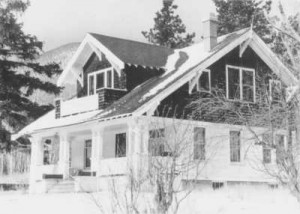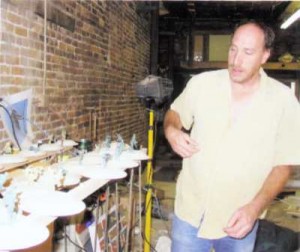Column by George Sibley
Economics – December 2003 – Colorado Central Magazine
LAST MONTH I was mucking about in the morass where private property and the public interest intersect. A fairly messy intersection in this society that doesn’t like to think about the balance between personal freedom and public responsibility.
More specifically, I was looking at some recent modifications to the Gunnison County Land Use Resolution. This “LUR” (which originally emerged out of some amazing early-70s state legislation to allow local governments to protect their jurisdictions from the unmitigated impacts of major developments like big water projects and ski resorts) is now being used in the Upper Gunnison as a kind of Trojan Horse.
No-change conservatives (mostly Democrats of the not-very-liberal sort) and economic libertarians (mostly Republicans of a not-very-conservative sort) keep pushing the LUR back and forth in endless “environment vs. economy” arguments. And recently the economic libertarians put a couple of changes into the resolution that are worth further consideration for anyone trying to figure out the politics of the 21st century.
One involved the permitting of “æsthetic solid fuel burning devices” — fireplaces, in plain language. A commonsensical person might wonder why this battle is being waged in the 21st century. Didn’t Ben Franklin recognize the folly of the open fireplace way back in the 18th century? Didn’t he invent a stove that was more efficient, and also offered the fire-watching æsthete an isinglass window in the stove door? I’ve got the new improved EPA-sanctioned result of that 250-year research — with a most indulgently æsthetic picture-window in the door — in my living room instead of a TV. And it offers better programming (except in the summer).
But the trouble with open fireplaces isn’t just the inefficiency; they pour significant amounts of particulate matter into the air that we all have to breathe. So it becomes a “commons” issue, or a “natural capital” issue, depending on which way you swing politically. It involves the natural capital that belongs to all of us — the air we all have to use. So it did seem to be “commons sense” to write “no fireplaces” into the LUR.
But fireplaces have a great deal of nostalgic appeal to some people — especially the kind of people who like to build big baronial manors with big baronial fireplaces. So the economic libertarians claimed (with no specific evidence that I’ve ever heard) that people were moving to Durango rather than Gunnison because they could have fireplaces in Durango.
And the economic libertarians raised the classic argument of the commons appropriator going back to John Locke: There’s so much air here, and so few fireplaces, that it can’t possibly make that much difference.
But the County Commissioners did at least effect a compromise between catering to nostalgia and commons sense. They said people could have a fireplace, but they would have to pay a $1,000 dollar fee for it. This is an attempt to discourage fireplaces without banning them, and it’s basically a good principle, I think, in an economically oriented society where freedom is valued more highly than responsibility.
The Commissioners did a similar thing with another change that the economic libertarians wanted in the LUR. In this case, houses with more than 5,000 square feet were considered a “major impact” — right up there with water projects and ski areas — but many objected to the resultant restrictions.
There is great ambivalence in the valley about megamanors. Even though, if pressed, a lot of people would probably have to admit that they would like to live in a mountain mansion, almost no one wants to look at them from the outside — especially when they crop up on a hillside that was formerly “open space.” But calling such houses a major impact meant that they had to go through a fairly long permitting process.
The economic libertarians argued — probably with more cause than on the fireplace issue — that this was discouraging people from building the big houses which insure the economic well-being of many Gunnison businesses. Who wants to build a big house in a place where the people don’t seem inclined to admire it?
SO THE COMMISSIONERS again bent to the wind and removed the “major impact” restriction from all houses with less than 10,000 square feet. But, once again, they imposed a fee on houses larger than 5,000 square feet: $5.00 a square foot for every square foot over 5,000. The money collected from this measure will go into a county affordable housing fund. Thus somebody who builds a 10,000 square-foot house will pay $25,000 for the privilege, which is a relatively negligible amount on a million-dollar megamanor. But it can make a considerable difference on one of those do-it-yourself homes for someone who actually wants to live and work here.
This strikes me as moving toward a good approach to the “commons” or “natural capital” issue in a society that almost desperately wants to remain something resembling “free.”
But if our cultural need is to educate people toward balancing freedom and responsibility, then the Commissioners did not go far enough. The county is still indulging “the freedom to do any dam-fool thing you think you can afford to do.”
Does anyone need the freedom to pollute our commons with their woodsmoke? Does anyone need a 5,000, 7,000, or 10,000 square foot house?
It is easier to argue against damage to the commons when that damage jeopardizes the air that we breathe than it is to argue against the cluttering of “open space.” But our community, like many others, is putting its money where its preference is on “open space,” through land trust purchases and conservation easements. Where does the open-space commons start and stop? Especially when, in a tourist/resort economy it is also our natural capital?
My problem with the path that our Commissioners have taken is that, while it moves in the right direction, it is way too timid. “The freedom to do any dam-fool thing you can afford” needs to be made more expensive in this economy, because of what it subtracts from our common wealth and natural capital.
Is the freedom to pollute the commons with an æsthetic fireplace, for example: a one-time cost?
No, from the perspective of the commons, we’ve given the æsthete a gift that keeps on giving us worse air year after year. So the æsthete should pay, year after year. How about $1,000 down and $500 per year for an “æsthetic burning device”? Or just round it up to $1,000 a year, at least as a point to start negotiating. And the money can be divided between a fund for local alternative energy research and a respiratory disease treatment fund at the hospital.
AS FOR THE BUILDERS of megamanors? Let’s see a good old progressive luxury tax there. Remember luxury taxes — from back before television made the flaunting of wealth patriotic? Houses of 2,000 square feet or smaller wouldn’t require such a tax — although Crested Butte miners raised families of eight or twelve kids in houses smaller than that. But for every thousand square feet above 2,000, the base tax doubles: $5 a square foot for the 2,000-3,000 square-foot category; $10 a square foot in the 3,000-4,000 square-foot category; etc.
And this won’t be a one-time fee; it will be an annual luxury tax, added on to the regular property taxes. It’s where I think we ought to at least start the negotiations between the no-change conservatives and the economic libertarians.
The economic libertarians would of course howl that no one would want to build here, but I don’t think that people planning to build 10,000 square foot houses are looking for cheap deals. It’s like the old saying about yachts: If you have to ask “how much” it is, you can’t afford it.
There are people willing to pay for that kind of exclusiveness. And even with only a relatively small number of huge houses, the resultant luxury tax could generate a real building boom of affordable homes for the kind of people who actually live and work here.
The bottom line, philosophically, is that freedom has always pretty much meant all the freedom you can afford before the responsibilities that just won’t go away kick in. And we have historically made freedom far too cheap by auctioning off our natural capital at fire-sale prices, while deferring the hidden costs to a future that is basically here now. We just can’t push these costs onto our kids anymore, let alone our grandkids.
George Sibley writes in Gunnison and teaches at Western State College.


